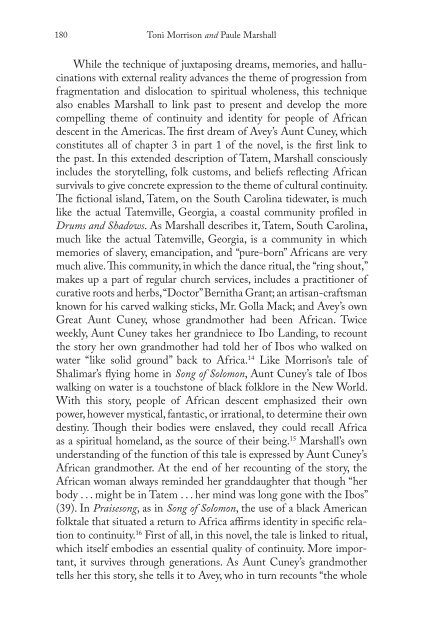Blooms Literary Themes - THE TRICKSTER.pdf - ymerleksi - home
Blooms Literary Themes - THE TRICKSTER.pdf - ymerleksi - home
Blooms Literary Themes - THE TRICKSTER.pdf - ymerleksi - home
Create successful ePaper yourself
Turn your PDF publications into a flip-book with our unique Google optimized e-Paper software.
180<br />
Toni Morrison and Paule Marshall<br />
While the technique of juxtaposing dreams, memories, and hallucinations<br />
with external reality advances the theme of progression from<br />
fragmentation and dislocation to spiritual wholeness, this technique<br />
also enables Marshall to link past to present and develop the more<br />
compelling theme of continuity and identity for people of African<br />
descent in the Americas. Th e fi rst dream of Avey’s Aunt Cuney, which<br />
constitutes all of chapter 3 in part 1 of the novel, is the fi rst link to<br />
the past. In this extended description of Tatem, Marshall consciously<br />
includes the storytelling, folk customs, and beliefs refl ecting African<br />
survivals to give concrete expression to the theme of cultural continuity.<br />
Th e fi ctional island, Tatem, on the South Carolina tidewater, is much<br />
like the actual Tatemville, Georgia, a coastal community profi led in<br />
Drums and Shadows. As Marshall describes it, Tatem, South Carolina,<br />
much like the actual Tatemville, Georgia, is a community in which<br />
memories of slavery, emancipation, and “pure-born” Africans are very<br />
much alive. Th is community, in which the dance ritual, the “ring shout,”<br />
makes up a part of regular church services, includes a practitioner of<br />
curative roots and herbs, “Doctor” Bernitha Grant; an artisan-craftsman<br />
known for his carved walking sticks, Mr. Golla Mack; and Avey’s own<br />
Great Aunt Cuney, whose grandmother had been African. Twice<br />
weekly, Aunt Cuney takes her grandniece to Ibo Landing, to recount<br />
the story her own grandmother had told her of Ibos who walked on<br />
water “like solid ground” back to Africa. 14 Like Morrison’s tale of<br />
Shalimar’s fl ying <strong>home</strong> in Song of Solomon, Aunt Cuney’s tale of Ibos<br />
walking on water is a touchstone of black folklore in the New World.<br />
With this story, people of African descent emphasized their own<br />
power, however mystical, fantastic, or irrational, to determine their own<br />
destiny. Th ough their bodies were enslaved, they could recall Africa<br />
as a spiritual <strong>home</strong>land, as the source of their being. 15 Marshall’s own<br />
understanding of the function of this tale is expressed by Aunt Cuney’s<br />
African grandmother. At the end of her recounting of the story, the<br />
African woman always reminded her granddaughter that though “her<br />
body . . . might be in Tatem . . . her mind was long gone with the Ibos”<br />
(39). In Praisesong, as in Song of Solomon, the use of a black American<br />
folktale that situated a return to Africa affi rms identity in specifi c relation<br />
to continuity. 16 First of all, in this novel, the tale is linked to ritual,<br />
which itself embodies an essential quality of continuity. More important,<br />
it survives through generations. As Aunt Cuney’s grandmother<br />
tells her this story, she tells it to Avey, who in turn recounts “the whole

















